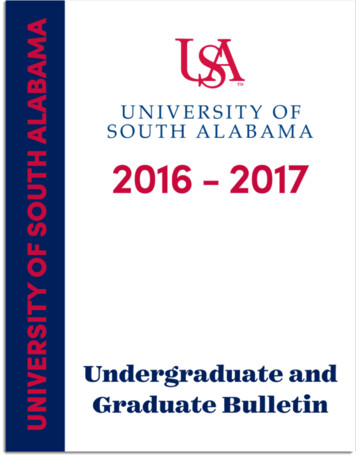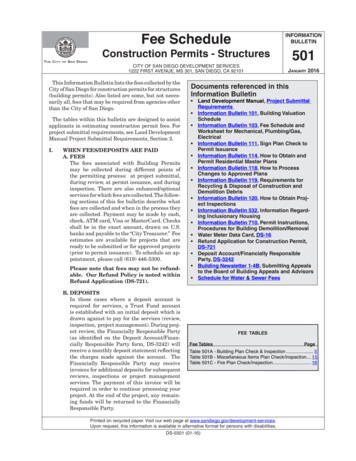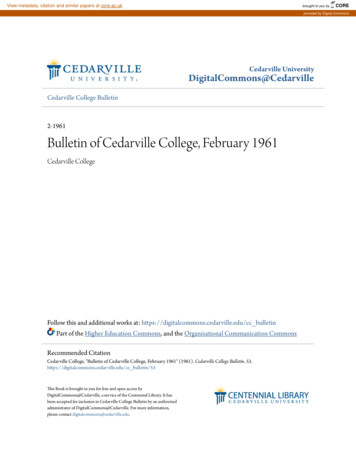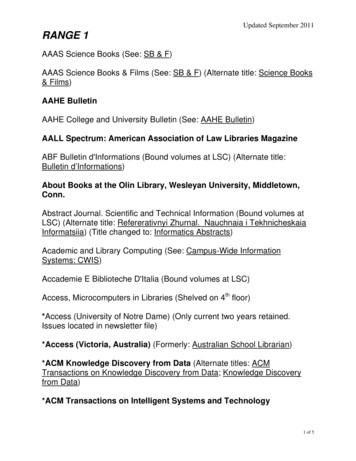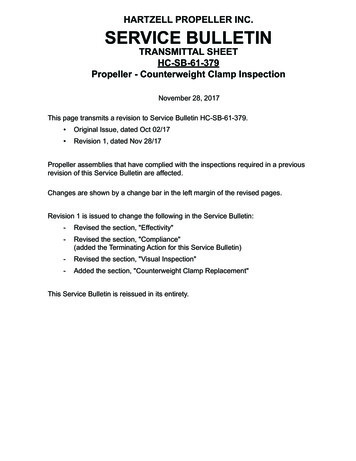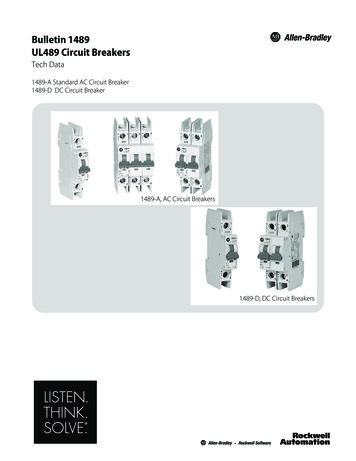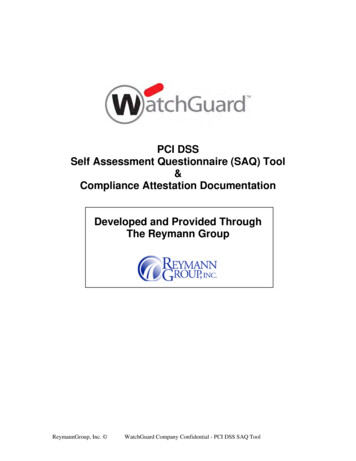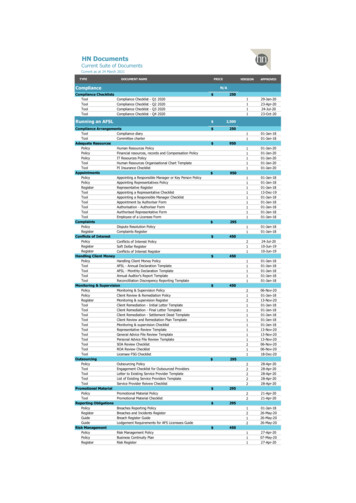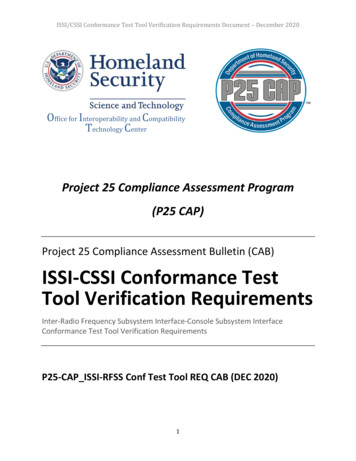
Transcription
ISSI/CSSI Conformance Test Tool Verification Requirements Document – December 2020Office for Interoperability and CompatibilityTechnology CenterProject 25 Compliance Assessment Program(P25 CAP)Project 25 Compliance Assessment Bulletin (CAB)ISSI-CSSI Conformance TestTool Verification RequirementsInter-Radio Frequency Subsystem Interface-Console Subsystem InterfaceConformance Test Tool Verification RequirementsP25-CAP ISSI-RFSS Conf Test Tool REQ CAB (DEC 2020)1
ISSI/CSSI Conformance Test Tool Verification Requirements Document – December 2020December 2020Notice of Disclaimer and Limitation of LiabilityThe Project 25 Compliance Assessment Program (P25 CAP) provides equipment purchasersdemonstrated evidence of a product’s compliance with a select group of requirements definedin the suite of P25 Standard. Although successful tests will demonstrate P25 compliance forthe specific requirements tested, the conclusions drawn from these tests do not apply to everyenvironment or individual users’ needs. P25 CAP-mandated tests only demonstrate productcompliance with the tested features listed in the Supplier’s Declaration of Compliance and,therefore, only attest to a product’s compliance with specific requirements within the P25Standard.Revision HistoryVersionDateV3.0Draft11/17/2020 Version 3.0 Draft internally reviewed, submission for 30-day publiccomment.Version 1.0Description12/30/2020 Initial release, includes resolutions of submitted comments from30-day public comment period.2
ISSI/CSSI Conformance Test Tool Verification Requirements Document – December 2020Table of ContentsNotice of Disclaimer and Limitation of Liability . 2Revision History . 2Table of Contents. 3List of Figures and Tables . 5Executive Summary . 6Effective Date . 6Document Glossary of Terms & Acronyms (see Appendix A) . 7Document References . 7TIA-102 Document References . 81. Introduction to this Document. 101.1 Purpose of this Document . 101.2 Introduction to Project 25 Interfaces . 101.3 Project 25 Compliance Assessment Program (P25 CAP) Introduction . 111.4 Importance of Verified Conformance Test Tools. 131.5 Types of ISSI/CSSI Conformance Testing . 141.6 ISSI/CSSI Conformance Test Tool Verification . 151.7 Alternate Conformance Testing Approaches . 182. Example Test Tool Verification Testing Methods . 182.1 Manual, Independent Assessment Using Protocol Analyzer . 192.2 Example 1 – ICC Test Tool in Self-Test Mode . 192.3 Example 2 – ICC Test Tool Testing Against Operational RFSS. 202.4 Example 3 – ICC Test Tools Back-to-Back . 203. Test Tool Testing Guidance and Requirements . 213.1 ICC Test Tool Testing Requirements and Assumptions . 213.2 First Test Tool Verification, Challenges and Recommendations . 233.3 Process Role Definitions for Test Tool Verification. 244. ICC Test Tool Verification Process Steps . 264.1 Step 1 – Initial Notification. 264.2 Step 2 – Checkpoint I - Kickoff Webinar . 274.3 Step 3 – Submit ICC Test Tool Verification Test Plan . 283
ISSI/CSSI Conformance Test Tool Verification Requirements Document – December 20204.4 Step 4 – Perform Test Tool Verification Testing . 314.5 Step 5 – Compile P25 CAP Submission Documents . 324.6 Step 6 – Approval & Notifications . 335. ISSI/CSSI Test Tool Testing – Scope of Features . 355.1 Test Document References. 355.2 Policies, Clarifications - All Testing . 355.3 [1] ISSI-RFSS Configuration – Conformance Testing . 365.4 [2] CSSI-RFSS Configuration – Conformance Testing . 385.5 [3] CSSI-Console Subsystem Configuration – Conformance Testing . 42Questions, Getting Started. 44Appendix A – Glossary of Terms and Acronyms . 45Appendix B – ICC Test Tool Verification Process Map. 524
ISSI/CSSI Conformance Test Tool Verification Requirements Document – December 2020List of Figures and TablesFigure 1. Overview of Key Project 25 Standards-based Interfaces. 10Figure 2. How a Verified ICC Test Tool Is Used in ISSI/CSSI Conformance Testing . 15Figure 3. Example 1 – ICC Test Tool in Self-Test Mode . 19Figure 4. Example 2 – ICC Test Tool Testing Against Operational RFSS . 20Figure 5. Example 3 – ICC Test Tools Back-to-Back . 21Figure 6. ISSI-RFSS Conformance Test Tool Verification . 36Table 1. ISSI-RFSS Group Voice - Conformance Test Case List . 36Table 2. ISSI-RFSS Supplementary Data - Conformance Test Case List . 38Figure 7. CSSI-RFSS Conformance Test Tool Verification . 38Table 3. CSSI-RFSS Group Voice - Conformance Test Case List . 40Table 4. CSSI-RFSS Unit to Unit Call - Conformance Test Case List . 40Table 5. CSSI-RFSS Supplementary Data - Conformance Test Case List . 41Figure 8. CSSI-CSS Conformance Test Tool Verification . 42Table 6. CSSI-CSS Group Voice - Conformance Test Case List . 43Table 7. CSSI-CSS Unit to Unit Voice - Conformance Test Case List. 43Table 8. CSSI-CSS Supplementary Data - Conformance Test Case List . 44Table 9. Glossary of Terms and Acronyms . 455
ISSI/CSSI Conformance Test Tool Verification Requirements Document – December 2020Executive SummaryThe Department of Homeland Security (DHS) Science and Technology Directorate (S&T)Office for Interoperability and Compatibility Technology Center (OIC-TC) Project 25Compliance Assessment Program (P25 CAP) is a voluntary program that allows P25equipment suppliers to formally demonstrate their products’ compliance with a selectgroup of requirements within the suite of P25 standards.This ISSI/CSSI Conformance Test Tool Compliance Assessment Bulletin (ICC Test Tool CAB)provides the verification procedures for test tool products that are designed to performconformance testing of P25 Inter-Radio Frequency (RF) Subsystem Interface (ISSI) andConsole Subsystem Interface (CSSI) equipment in accordance with P25 CAP ISSI and CSSIConformance Test Cases and Pass/Fail documents, creating a robust and repeatableverification program in accordance with applicable DHS S&T and P25 CAP technical andreporting requirements.This document has been preceded by a fully-vetted preliminary version, entitled P25 CAPISSI/CSSI Conformance Test Tool Verification Process – Interim Guidance Document v6.0.This document provides expansive detail on how and why the process evolved. This ICCTest Tool CAB draws heavily upon that document and, as planned, replaces the interimguidance with the final and official processes and procedures contained herein.Intended users of ICC Test Tool verification procedures include organizationsindependently verifying ICC Test Tool products, vendors developing commercial ICC TestTool products, ISSI/CSSI equipment conformance testing laboratories, entities conductingpilot-testing of ICC Test Tool products, and manufacturers developing detailed andsummary technical and related reports of ICC Test Tool products for DHS S&T and P25 CAPpurposes. 1The intent in applying ICC Test Tool products in practice is to significantly increase enduser confidence in the procurement and operation of ISSI/CSSI equipment that meetsstandards and is interoperable and the basis of meeting Federal government grantprograms. 2Effective DateThis ICC Test Tool CAB becomes effective on December 30, 2020.1 See ICCTT Interim Guidance Document, page 4, Section 1.1.2 Ibid., page5, Section 1.2.6
ISSI/CSSI Conformance Test Tool Verification Requirements Document – December 2020Document Glossary of Terms and Acronyms (see Appendix A)Document ReferencesThe section below provides a list of the primary references for this document. Otherdetailed reference information is embedded in the material or listed in numberedfootnotes. The versions and filenames current as of this revision are provided, howeverpractitioners are encouraged to verify which is most current version available by checkingthe DHS P25 CAP website. Certain documents such as the Test Case documents, thePass/Fail Criteria and the Summary Test Report (STR) and Suppliers Declaration ofCompliance (SDOC) template documents are available only by request via email toP25CAP@hq.dhs.gov.[1][2][3][4][5][6]ISSI-RFSS Conformance Test Case Document – Project 25 Compliance AssessmentProgram ISSI-RFSS Conformance Test Cases; current version: December 2020.Filename: P25-CAP ISSI-RFSS Conf Test REQ CAB (DEC 2020).pdfCSSI-RFSS Conformance Test Case Document – Project 25 ComplianceAssessment Program CSSI-RFSS Conformance Test Cases; current version: December2020.Filename: P25-CAP CSSI-RFSS Conf Test REQ CAB (DEC 2020).pdfCSSI-CSS Conformance Test Case Document – Project 25 Compliance AssessmentProgram CSSI-CSS Conformance Test Cases; current version: December 2020.Filename: P25-CAP CSSI-CSS Conf Test REQ CAB (DEC 2020).pdfISSI/CSSI Conformance Test Pass/Fail Criteria – Project 25 ComplianceAssessment Program ISSI/CSSI Conformance Test Pass/Fail Criteria; current version:December 2020.Filename: P25-CAP ISSI-CSSI Conf Pass-Fail Criteria (Dec 2020).pdfP25 CAP ISSI/CSSI Conformance Test Tool Verification Process – InterimGuidance Document v6.0, July 2020 – This interim guidance document was usedas the basis for this document and is referenced heavily throughout. A significantamount of content from this document were carried forward into this final CAB (asplanned).Filename: P25CAP ICCTT Verification Interim Guidance Doc v6.0 (7-31-20).pdfISSI/CSSI Conformance Test Requirements CAB – Project 25 ComplianceAssessment Program baseline ISSI/CSSI Conformance Test Requirements ComplianceAssessment Bulletin; current version: December 2020.7
ISSI/CSSI Conformance Test Tool Verification Requirements Document – December 2020Filename: P25-CAP ISSI-CSSI Conf Test REQ CAB (DEC 2020).pdfTIA-102 Document BACA-B] Project 25 Inter-RF Subsystem Interface Messages andProcedures for Voice Services, Mobility Management, and RFSS CapabilityPolling Services; TIA-102.BACA-B, TIA, November 2012.[102BACA-B-1] Project 25 Inter-RF Subsystem Interface Messages andProcedures for Voice Services, Mobility Management, and RFSS CapabilityPolling Services, Addendum 1- Group Emergency Behaviors; TIA-102.BACAB-1 (Addendum to TIA-102.BACA-B), TIA, July 2013.[102BACA-B-2] Project 25 Inter-RF Subsystem Interface Messages andProcedures for Voice Services, Mobility Management, and RFSS CapabilityPolling Services, Addendum 2- Erratum 1 to Fix Errors and Omissions; TIA102.BACA-B-1 (Addendum to TIA-102.BACA-B), TIA, November 2016.[102BACD-B] Project 25 Inter-RF Subsystem Interface Messages andProcedures for Supplementary Data; TIA-102.BACD-B, TIA, July 2011.[CACC][102CACC] Project 25 Inter-RF Subsystem Interface Conformance TestProcedures; TIA-102.CACC, TIA, January 2009.[CACD-D][CACD-D] Project 25 Inter-RF Subsystem Interface Interoperability TestProcedures for Trunked Voice Operation Involving the ISSI; TIA-102.CACD-C,TIA, November 2018.[CACC-1][CABC-C][102CACC-1] Project 25 Inter-RF Subsystem Interface Conformance TestProcedures- Addendum 1- Supplementary Data; TIA-102.CACC-1, TIA,August 2011.[CABC-C] Project 25 Interoperability Testing for Voice Operation in TrunkedSystems; TIA-102.CABC-C, TIA, February 2017.8
ISSI/CSSI Conformance Test Tool Verification Requirements Document – December 2020This page has been left blank intentionally.9
1.ISSI/CSSI Conformance Test Tool Verification Requirements Document – December 2020Introduction to this DocumentThis section describes the purpose of this document, the scope, intended audience(s) andthe importance of establishing a robust ICC Test Tool Verification Process. This documentalso provides a brief overview of Project 25 (“P25”) TIA-102 Standards-based interfaces, anintroduction to the P25 Compliance Assessment Program (“P25 CAP”) and a description ofthe types of testing the program supports.1.1Purpose of this DocumentThe purpose of this ICC Test Tool CAB document is to clearly convey the procedures,requirements and guidance necessary to achieve DHS S&T P25 CAP approval andrecognition of an ISSI/CSSI Conformance Test Tool.1.2Introduction to Project 25 InterfacesThe TIA-102 suite of Project 25 specification and standards documentation establishes theoperation and behaviors of P25 standards-based features and functions. The Project 25TIA-102 standards suite is comprehensive, with documents that precisely specify themessage sequences, message content and exchange procedures for P25 Interfaces. P25Interfaces include over-the-air, called Common Air Interfaces (“CAI”), and wireline10Figure 1. Overview of Key Project 25 Standards-based Interfaces
ISSI/CSSI Conformance Test Tool Verification Requirements Document – December 2020interfaces that operate over a network.This paper is focused on conformance to the standards specifications of the P25 Inter-RFSubsystem (“ISSI”) and Console Subsystem (“CSSI”) wireline interfaces.Figure 1 shows the primary types of end user devices: mobile Subscriber Units (“mSUs”)and Console Dispatch Operator positions (“cSUs”). A P25 Trunked RF Subsystem (RFSS A)is shown equipped with P25 base repeaters using the P25 CAI. RFSS A is also connected toP25 RFSS B using the P25 ISSI/CSSI wireline interface standard. Finally, the P25 trunkedsystem RFSS B is connected to a third-party P25 Console Subsystem (CSS B’) using the P25CSSI interface.For the purposes of this paper, the combined acronym “ISSI/CSSI” is used as a shorthandand refers to any aspects that apply equally to the ISSI and CSSI interfaces.1.3Project 25 Compliance Assessment Program (P25 CAP)IntroductionThe Project 25 Compliance Assessment Program (“P25 CAP”) is a voluntary program thatallows P25 equipment suppliers to formally demonstrate their products’ compliance with aselect group of requirements within the suite of P25 standards. The purpose of theProgram is to provide emergency response agencies with evidence that thecommunications equipment they are purchasing meets P25 standards in three key areas:performance, conformance, and interoperability. 3The P25 CAP is administered independently of the P25 standards creation, publication andmaintenance. It is intended to provide assurance to users that the equipment tested withinthe program will perform, interoperate and conform to the messages, message sequenceand message content described by the standards.This material is exclusively focused on verification and recognition of ICC Test Toolproducts and has been developed to assist public safety technology entities, includingprivate corporations interested in developing commercially available ICC Test Tool productand any organization working to independently verify ICC Test Tool products.All equipment suppliers that participate in the P25 CAP must use DHS-recognizedlaboratories to conduct performance, conformance and interoperability tests on theirproducts. The P25 CAP defines the tests to be run to determine compliance and the formatfor consistently reporting results of interest to the market. It also ensures that the3See Ref [5], page 5.11
ISSI/CSSI Conformance Test Tool Verification Requirements Document – December 2020laboratories and laboratory personnel follow strict guidelines for ensuring that repeatableresults can be consistently obtained by qualified testers or test equipment regardless ofwhich P25 CAP-recognized lab performs the testing. The lab accreditation includesverifying the ability of the testers to perform the tests and determine if the results meet thePass/Fail criteria.To verify compliance to the Telecommunication Industry Association (TIA)-102 P25standards specification, the P25 CAP implements three categories of tests. These areInteroperability Testing, Performance Testing and (protocol) Conformance Testing, and aredescribed further below.1.3.1P25 Interoperability TestingP25 Interoperability testing verifies that the operation and behavior of the implementationmatches the operation and behavior described by the P25 standards. This type of testing isoften described as “end to end” testing, reflecting the focus on the behaviors of the end usermobile and portable subscribers and dispatch console positions. In the P25 WirelineInterface context, this is accomplished by connecting CSS or RFSS equipment to both endsof the interface and using this equipment to stimulate traffic and carefully observeresulting behavior of the network, stations and devices.Interoperability tests describe the equipment configuration and operational steps thatsimulate specific and precise operational behaviors, which are specified and preciselydefined in P25 TIA-102 standards. Because interoperability test pass/fail are usually basedupon observation, test equipment is not currently used in this category. Theinteroperability tests also establish Pass/Fail criteria that enables P25 test cases to beconsistently implemented, tested, measured and assessed by P25 CAP test engineers.However, while interoperability testing involves monitoring the visual and audiblebehaviors of end user subscriber radios and consoles, additional equipment may benecessary to fully verify functionality in a wider variety of configurations and end userscenarios.The P25 CAP recognizes the need to continue enhancing the scope and robustness ofISSI/CSSI interoperability testing and is exploring additional approaches and methods tomore readily reveal potential end user interoperability issues and obstacles.1.3.2P25 Performance TestingWith the increased performance demands inherent to managing highly complex RF devicesin a highly complex interoperability environment, P25-compliant CAI and networkperformance testing provide a critical underpinning to the reliability, robustness and12
ISSI/CSSI Conformance Test Tool Verification Requirements Document – December 2020interoperability of P25 radios, base stations and RF subsystems. Building upon the FederalCommunications Commission (FCC) certification, the P25 performance test suite includesintricate functional testing, verification of receiver sensitivity, faded reference sensitivity,adjacent channel rejection performance, throughput delay, transmitter attack time andtransient frequency behaviors, just to name a few.P25 Performance testing is established for the wireless CAI domain and is currently outsidethe scope of wireline interface testing. It is included here for a comprehensive view of P25CAP.1.3.3P25 Wireline Conformance TestingConformance tests verify that interoperability is a result of the implementation havingimplemented the messages, message exchange procedure and certain message contentdefined in the TIA-102 ISSI/CSSI BACA suite of standards documents.Conformance tests describe the equipment configuration and operational steps thatsimulate the standard operation and behavior as well as the messages, message sequenceand message content that determine Pass/Fail criteria of the test. Pass/fail criteria mayalso determine whether the implementation processes optional message content per thestandard. Test equipment is needed to capture actual messages, message sequence andmessage content.As required by the lab accreditation process the P25 Test Engineer is trained on theconfiguration and operation of the equipment, has knowledge of the standard, is capable ofexecuting the test, is capable of operating the test equipment, and is familiar with thepass/fail criteria that determine if the captured messages, message sequence and messagecontent meet the pass/fail criteria.1.4Importance of Verified Conformance Test ToolsThis section outlines the importance of verifying Conformance Test Tools and how theyfunction as crucible of reliability within the overall P25 Standards ecosystem. The intent inapplying ICC Test Tool products in practice is to significantly increase public safetyindustry confidence that P25 ISSI/CSSI equipment meets P25 standards and isinteroperable. 4Here are some of the reason’s robust verification of ICC Test Tools is important:4See reference [5] ICC Test Tool Interim Guidance Document, Section 1.2, page 5.13
ISSI/CSSI Conformance Test Tool Verification Requirements Document – December 2020 1.5Because Conformance Test Tools verify that the underlying protocolmessages are consistent with the P25 Standards, the testing helps preventmistakes in the interface behavior that could result in disruptions to publicsafety operations. More importantly, if the messaging is incorrect, thisrequires new software code that would likely be expensive, difficult and takemonths, even years to address.The availability of robust, effective Conformance Test Tools will makedevelopment of P25-standards based interfaces more efficient and speedtime to market.Any errors in the tools, test cases or testing procedures could miss errors incommercial products, reducing reliability and potentially resulting ininteroperability problems and operational disruptions.Important form of technical verification fills a critical gap in the P25standards compliance, relying until now on cooperation of manufacturers,trial and error in early implementations, and feedback from customerdeployments.Types of ISSI/CSSI Conformance Testing 5Because this endeavor focuses exclusively on protocol conformance testing, additionaldetail on the types of conformance testing is provided below. For each of the sets ofapplicable requirements identified above, four types of ISSI/CSSI equipment conformancetesting are involved and described below. 5MSC Conformance Testing – Whether the Message Sequence Chart (MSC)was followed in accordance with applicable requirements. This applies tomessages issued by the ICC Test Tool product and by the real or simulatedEquipment Under Test (EUT).Message Content Conformance Testing – Whether the protocol messagecontent was exchanged in accordance with applicable requirements. Thisapplies to messages issued by the ICC Test Tool product and by the real orsimulated EUT.Parameter Values Pass/Fail Conformance Testing – Whether thePass/Fail criteria were satisfied in accordance with applicable requirements.This applies to messages issued by the ICC Test Tool product and by the realor simulated EUT.See reference [5], Section 4.2 page 20.14
ISSI/CSSI Conformance Test Tool Verification Requirements Document – December 2020 1.6Overall ICC Test Tool Product Verification – Whether all applicabletechnical requirements were satisfied, including those requirements relevantto the ICC Test Tool product verification environment (e.g., testingconfiguration and connection types), and also that sufficient information canbe obtained to satisfy the reporting requirements and that any otherverification criteria stated in the verification plan have been satisfied.ISSI/CSSI Conformance Test Tool VerificationThe following section examines the general concepts and provides context for verifying theprotocol behaviors for the P25 wireline ISSI/CSSI interfaces, in particular. This section willoutline how a verified ICC Test Tool will be used, provide a generic functional overview ofan ICC Test Tool, some of the unique challenges and considerations around the “testing oftest tool” category of Compliance Assessment and, lastly, why robust testing of ICC TestTools is so critical.1.6.1How a Verified ISSI/CSSI Conformance Test Tool Will Be UsedWhen testing the conformance to the digital messages and protocols defined by the P25TIA-102 BACA standards documents, a baseline test configuration is used and shownFigure 2. How a Verified ICC Test Tool Is Used in ISSI/CSSI Conformance Testingbelow.The illustration shows an ISSI/CSSI Enabled RFSS as the EUT, connected via an ISSI/CSSIinterface to the P25 CAP Verified ICC Test Tool that is simulating RFSS 2. The illustrationalso shows a P25 CAP Test Lab Technician using the plain language graphical user interface(“GUI”) from the ICC Test Tool to generate a detailed ISSI/CSSI conformance “EUT TestReport,” as shown.The EUT shown in Figure 2 could be a real or simulated RFSS, CSS, or a console integratedwith a RFSS and referred to as a “Native Console.” In this general testing arrangement, theTest Tool EUT equipment takes on the role as RFSS 1 and the ICC Test Tool simulates the15
ISSI/CSSI Conformance Test Tool Verification Requirements Document – December 2020messages of an RFSS or CSS, taking on the role of RFSS 2. Within the general testingarrangement, the ICC Test Tool reports the extent to which the equipment under testpasses or fails each test in accordance with applicable test case, role and Pass/Failrequirements. 6The procedures in the Conformance Test Cases are segmented into three distinctequipment-under-test (EUT) configurations. These test configurations are: 1) ISSI testingfor RFSS equipment, 2) CSSI testing for RFSS equipment, and 3) CSSI testing for CSSequipment. These configurations are illustrated and described in more detail in the TestCase overview section 5 of this document.1.6.2Overview of Conformance Test Tools 7This section provides a high-level overview of ISSI/CSSI Conformance Test Toolfunctionality, with additional details and information available in the body of thisdocument. Although functionality may vary by ICC Test Tool solution provider to addressmarket requirements, suggested, typical ICC Test Tool commercial products include, butare not limited to, the capabilities and functions listed below. Decode and validate that the P25 protocol messages flowing from the EUTcontain the correct information and are in the correct sequence as defined inthe TIA-102 standard;Perform all Test Cases as defined for each EUT System configurationsupported;Indicate an accurate assessment of “Pass” or “Fail” for each test case with logfiles;Provide detailed logs for reference during troubleshooting and debugging;Display and provide plain
Office for Interoperability and Compatibility Technology Center (OICTC) Project 25 - Compliance Assessment Program (P25 CAP) is a voluntary program that allows P25 . Procedures for Supplementary Data; TIA-102.BACD-B, TIA, July 2011. [CACC] [102CACC] Project 25 Inter -RF Subsystem Interface Conformance Test . TIA-102 standards suite is .
